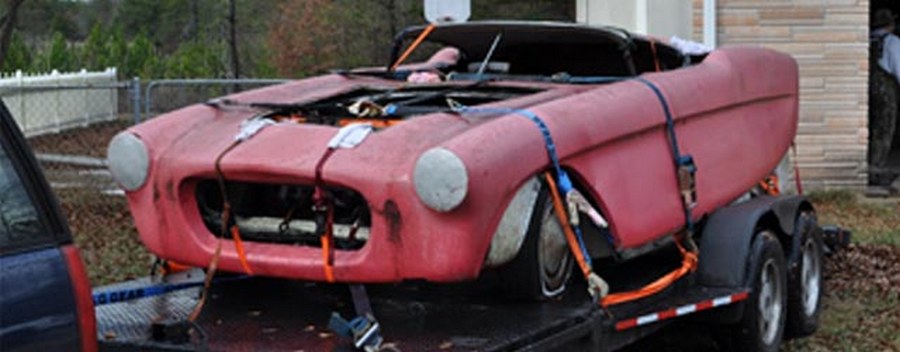
Hi Gang…
I’ve taken U.S. Mark II research as far as I can go.
With the help of good friends Alden Jewell, Scott Odell, and Pat Amedolia, we’ve shared what we can and now turn the reins over to U.S. Mark II owner Marshall Foxworthy to shine the light down the path of research on this fiberglass company from Norwood, New Jersey.
And as you know from previous stories here at Forgotten Fiberglass, Marshall Foxworthy has not been slacking. He’s roared to action and has more to share. Let’ see what Marshall’s learned about the company, its history, and this beautiful sports car from Northeast New Jersey.
Take it away Marshall!
The U.S. Mark-II Plot Thickens……
By Marshall Foxworthy
Forgotten Fiberglass Correspondent – U.S. Fiberglass Mark II
In the research of the Mark-II, many questions were answered and many more surfaced.
This almost sounds like a cliché for anyone researching something as obscure as an old fiberglass car body with only a few pictures and blurbs to follow. With the advantages of modern technology, Geoff Hacker and Forgotten Fiberglass, the task became easier.
Here will be presented more characters in this “play”. The once obscure fiberglass body with its known pedigree will now have a “face” with its own unique history.
Brian Clark
Brian Clark is where we pick up the trail for the recent Mark-II body. Mr. Clark, now living in Port Jervis, NY, had acquired the body from a friend whose father had passed away. This friend’s father is thought to have purchased three of these bodies.
After apparently building two of these bodies into completed cars, this one remained unfinished. According to Mr. Clark, the car was on a wooded property and had been there for some 20 years. The bottom edge was buried in the soil. He reported that there were also small trees growing through the cockpit opening that had to be cut down in order to extricate the shell.
Mr. Clark cleaned the body with bleach revealing an aqua colored gel coat, more on this later. He painted the shell its present red and had planned to shorten it to fit on a chassis with a much smaller wheel base. The shell was sold on EBay to Scott Odell around 2002-2003.
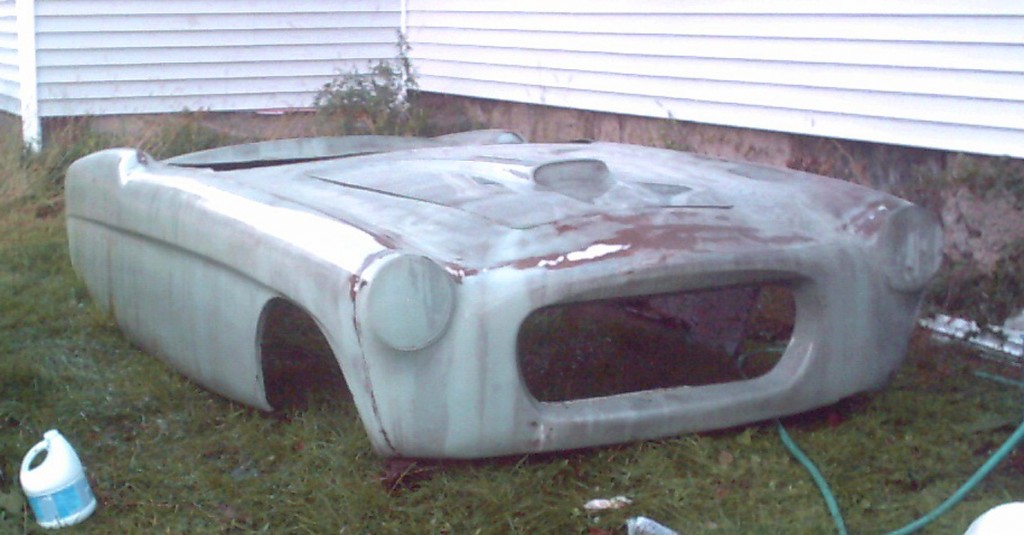
Here is a picture of the shell as cleaned up by Mr. Clark. The color has been corrected to reflect the true appearance of the gel-coat.
Pat Amendolia
In several conversations with Pat Amendolia about the Mark-II, he recounted the purchasing of possibly more than a dozen Mark-II bodies from someone associated with U.S. Fiberglass around 1957-1958.
U.S. Fiberglass had filed bankruptcy in late 1956 to early 1957. It is possible that this was a trustee, more on this later as well. After the deal was made, the bodies were loaded in a large truck. Pat remembers that he was not present when they arrived.
The driver had his home address and that is where they were delivered. Pat said that when he arrived home he found the yard of his modest abode covered in Mark-II bodies. Everywhere you looked was a fiberglass body by U.S. Fiberglass. His yard could not be seen.
Pat now having to transport these to his shop did so, one at a time, upside down, on the top of his Henry-J. Pat noted that all of the bodies were an aqua green, the same noted by Brian Clark. The color was from the gel coat used.
He speculated that this color may have resulted from the fact that U.S. Fiberglass produced a small garden pool and the gel coat and laminating resin used on both was the same. The son of U.S. Fiberglass president, Howard E. Greene, confirmed that the colors were the same, more on the Greene family later.
Pat lined up the bodies in front of his shop by the side of the road. He remembers selling most of them to people that would stop by and inquire. We’re hoping he can find some vintage photographs that documented the day the bodies arrived.
Below are a few close up pictures of a piece of the Mark-II body. The gel coat is an Aqua color. The layup appears to be 2 layers of matt and a final layer of cloth. The resin used is an opaque beige color. It is speculated this is because it had fillers to thicken it up. Most likely the garden pools and the Mark-II shared materials.
The Greene Family
It was interesting to try and find the family of Howard Greene. It appears that there was more than one Howard Greene in the fiberglass business.
Mentioned on Forgotten Fiberglass was Howard Greene who worked for Victress. I found a Howard Edward Greene who owned a fiberglass company in Florida. Last but not least was Howard E. Greene of U.S. Fiberglass. The latter had passed away in his 90’s in Key Largo, Florida.
With a little more searching, I found that Mr. Greene’s widow had moved to St. Augustine, FL to be near her daughter Ruth. Upon tracking down Ruth, I called and talked with her friend. I explained what I was researching and they thought I had the wrong family.
They knew from Ruth that Howard had been in the office equipment business. I politely left my number and asked them to pass along the information to her. I thought this was another dead end. Later in the day I was underneath the Mark-II shell taking pictures when the phone rang. It was Ruth’s friend and indeed her father had been in fiberglass in New Jersey in the 1950’s.
We had found the family. These conversations lead to Dr. Michael Greene of Boston, Ruth’s older brother. He was thankful that I had contacted the family. The family had moved from Philadelphia to River Vale, New Jersey in 1954. He remembered going to the factory in Norwood a couple of times with his dad when he was 9 or 10. There he saw the Mark-II bodies in the process of being made as well as other items. From discussions with Michael and other resources we can begin to construct a picture of the company.
Company History
U.S. Fiberglass Industrial Plastics, Inc. was incorporated in 1952, most likely in Philadelphia, PA. According to an article in Billboard Magazine, November 6, 1954, the company was going public and would produce their own products.
According to this article they had prototypes made in preparation for this move. They made much more than just a car body. There were large presses in the factory where fiberglass fabric and resin would be made into various parts. The car came along a few years later and was shown in several 1956 publications.

Here is an article from the November 6, 1954 issue of Billboard Magazine. It outlines the IPO for U. S. Fiberglass and their plans.
Michael remembers seeing some of the publicity photos including the one taken on Weremus Road, the one on the post card. He remembers his mom giving Howard some flack over the pretty models having their photos taken with the car. Some of which were at a New York auto show.
He remembers the rail road siding next to the plant where the fiberglass bodies and parts would be loaded in box-cars. The freight company was accustomed to charging by weight. They however did not agree to this for the fiberglass products. They were lighter and Mr. Greene had to negotiate a shipping price per piece.
The products that U.S. Fiberglass produced varied quite a bit. In 1954 they started with an archery bow. It was press molded in a dark green resin. This was to be followed by merry-go-round horses, film containers, film reels, beer and soft drink cases and a 12 drink cooler with dry ice compartment.
Michael also remembers the company producing welding helmets, milk boxes, snow saucers and a Rudolf the red nose reindeer for Christmas. They also produced a kidney shaped garden pool. It was about 3’ by 5’ and 30” deep. It was sold under the name Tricher Pools. The package also included the fish and plants.
Michael remembers that they had one of these pools in the back yard of their home. One of his memories was of the family pet, a German shepherd, chasing the fish in the pool and about drowning himself in the process. The pool and Mark-II bodies apparently shared the same color Gel coat and lay up resin.
It was thought that U.S. Fiberglass may have been involved in boats. Michael remembers some talk of boats but does not think any were made. It appears that by 1957 the company was trying to reorganize under a chapter 10 bankruptcy and planned another stock offering.
There were some issues with the Securities Exchange Commission and it is unclear if the company ever resolved these. Most likely the company was liquidated around 1957 to 1958. This may be the period of time Pat Amendolia bought the bodies from the “trustee”.
After U. S. Fiberglass, Howard E. Greene moved into the office supply business, as Ruth’s friend had thought, and retired to Key Largo, Florida where he lived into his 90’s.
As we have seen in previous articles here on Forgotten Fiberglass, the original Victress S-4 design was an inspiration to others. To be “re-thought” in the three known forms (Victress S4, U.. Mark II, Almquist el Morocco) is a testament to the strength of the design.
Although we have not yet uncovered the artisan who modified the front end to form the U.S. Fiberglass issue, dare we speculate in tribute to the S-4 this car was named the “Mark-II”?

This ad appeared in the October 16, 1954 issue of Billboard Magazine. The ad was to find investors for the company stock.
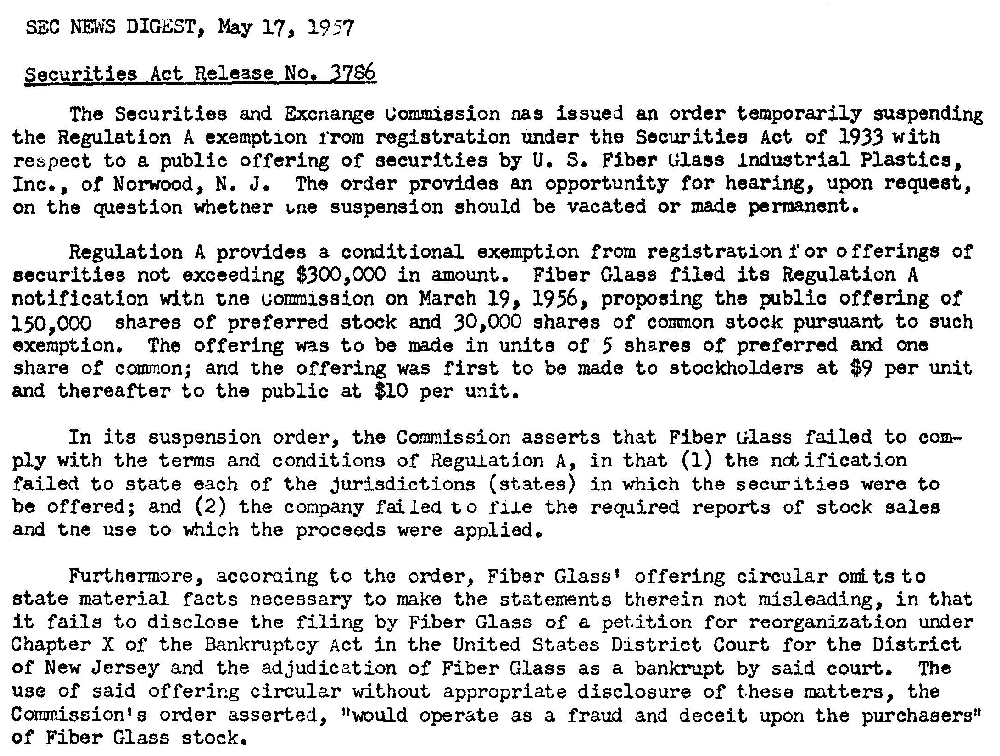
This Paragraph is from the May 17, 1957 “Securities Exchange Commission News Digest”. It outlines issues with another stock issue from U.S. Fiberglass.
Latest News: U.S. Fiberglass Logo Reproduction
Waste not, want not.
Marshall Foxworthy wastes no time and has already begun working on the crest or badge for the front of his car. Below is his first draft of a new logo in color followed by the logo of the company in black and white from original U.S. Fiberglass Company literature.
Summary:
We look forward to hearing from Marshall Foxworthy as he continues pushing the research envelope forward and begins restoration and completion of his U.S. Fiberglass Mark II Sports Car.
Hope you enjoyed the story, and until next time…
Glass on gang…
Geoff
——————————————————————-
Click on the Images Below to View Larger Pictures
——————————————————————-
- Here is a picture of the shell as cleaned up by Mr. Clark. The color has been corrected to reflect the true appearance of the gel-coat.
- Here is an article from the November 6, 1954 issue of Billboard Magazine. It outlines the IPO for U. S. Fiberglass and their plans.
- This ad appeared in the October 16, 1954 issue of Billboard Magazine. The ad was to find investors for the company stock.
- This Paragraph is from the May 17, 1957 “Securities Exchange Commission News Digest”. It outlines issues with another stock issue from U.S. Fiberglass.
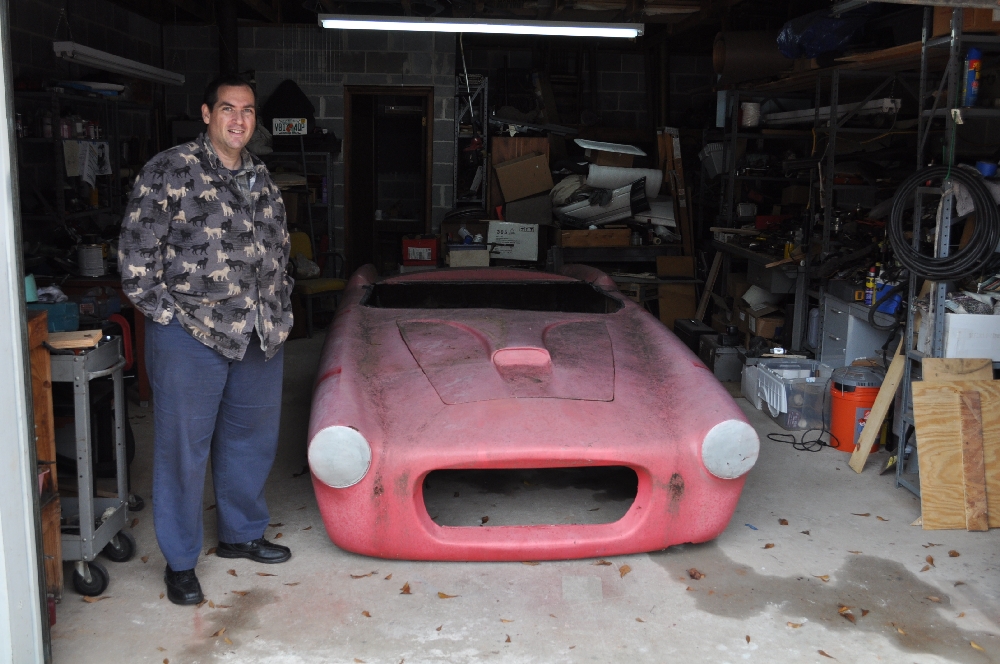


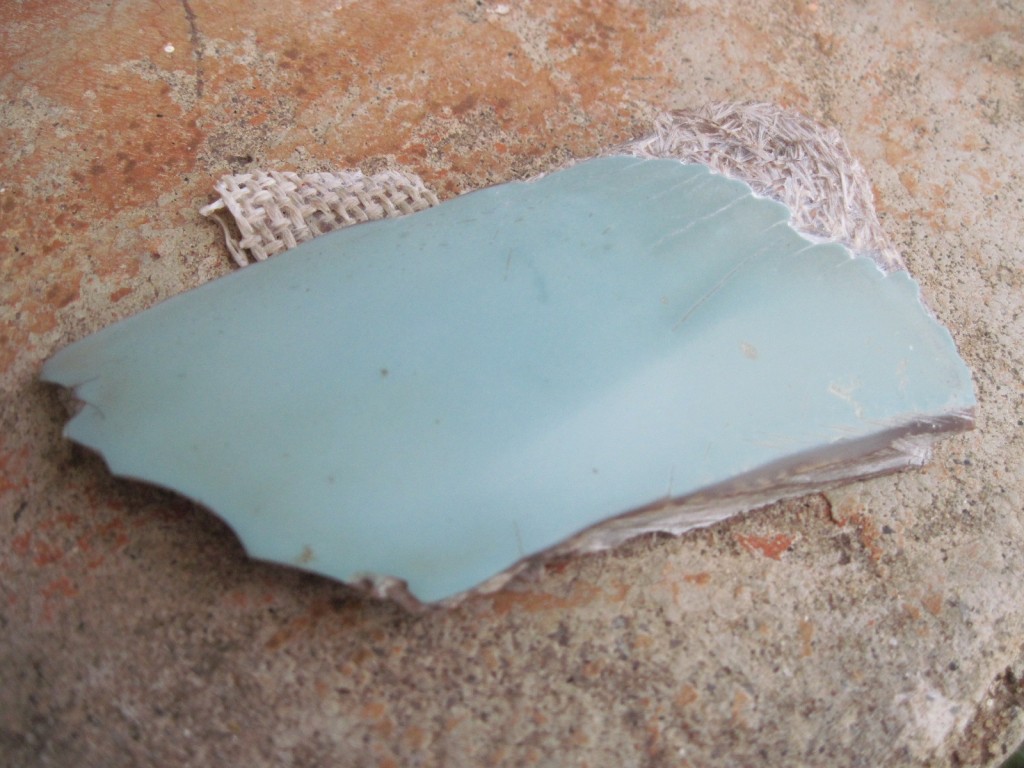
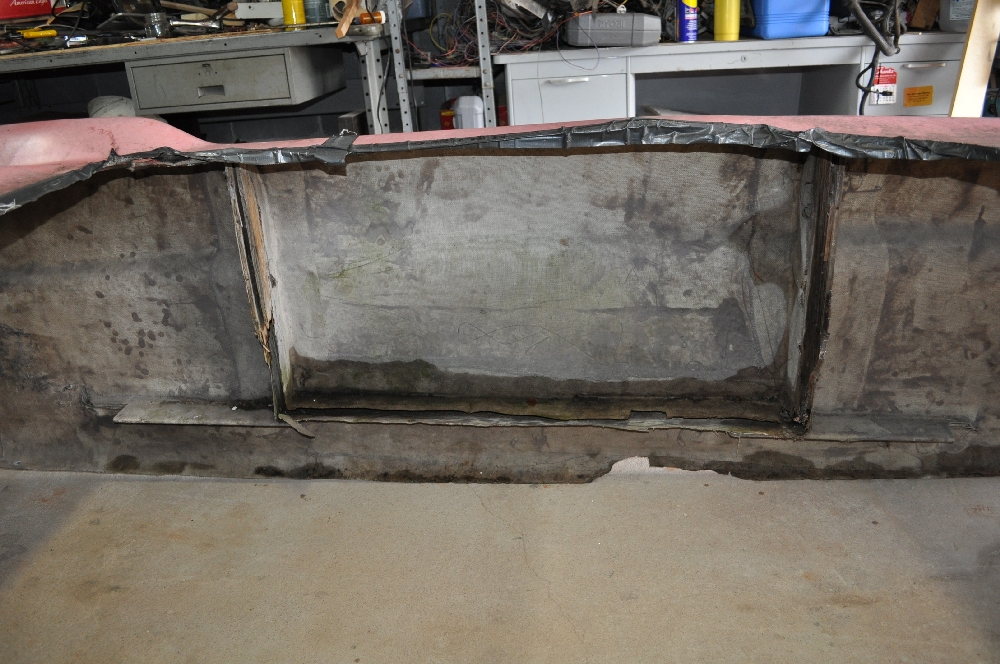
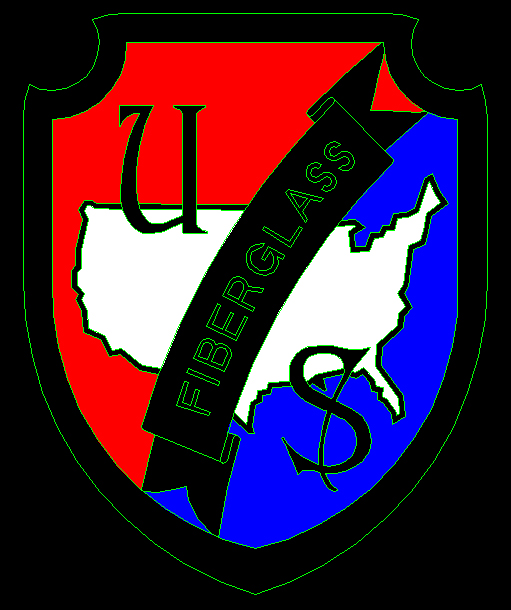
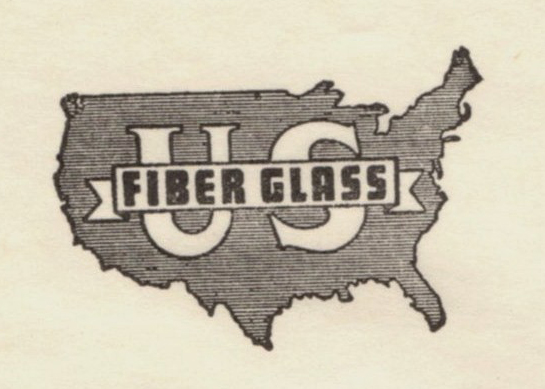

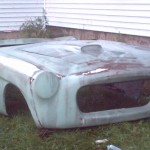
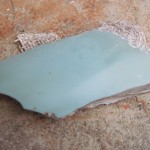
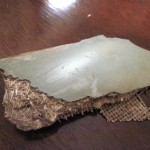
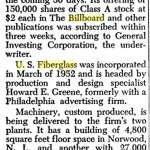
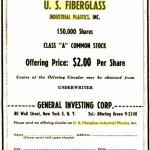
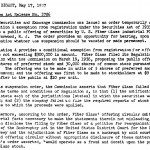
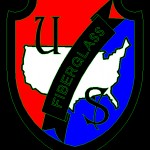
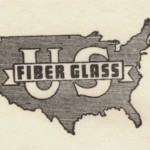
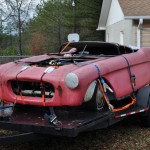
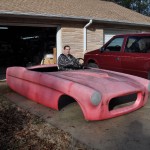
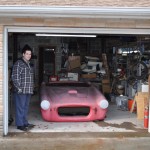
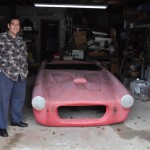
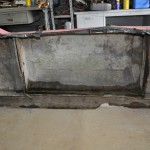
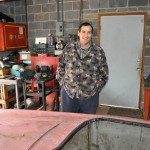
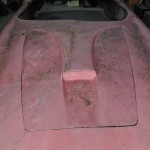
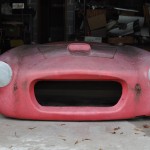
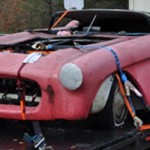
Pingback: The Abandoned “Record Plant” in River Edge, NJ – Abandoned River Edge, NJ
re: US Fiber Glass Industrial Plastics…I’m wondering if the factory was ACTUALLY in River Edge, NJ. There are a series of abandoned factories on the Hackensack River, hidden behind homes on Kinderkamack Rd. that were owned by this company and sold at auction as part of the liquidation of US Fiber Glass’ bankruptcy in 1957. The factories housed a few different businesses in the 1950’s, all in the plastic and fiber glass business. Your article mentions the son of Mr. Greene remembering the factory being alongside the train tracks…which these factories are.
You can see a finished copy of the same car, but with a hard top and 54 Ford windshield, photo taken circa 1983
http://www.forum.forgottenfiberglass.com/viewtopic.php?f=5&t=1120
Ed Reutling reutling embarqmail com
Lets see some photos of the finished car or (nearly finished)..
Great research, Marshall; keepit up. Like the logo, too.